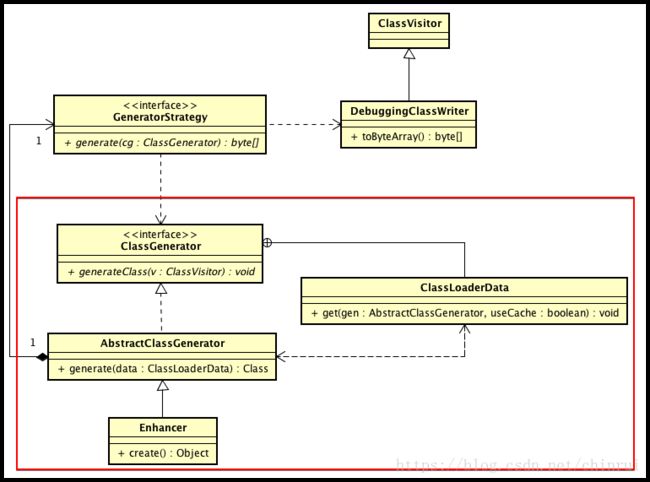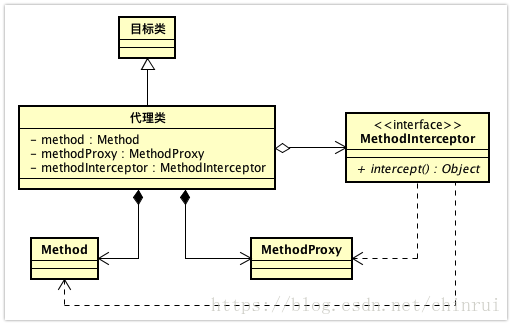Cglib动态代理实现解析
在 JDK 动态代理源码解读 已经知道了JDK 动态代理的实现逻辑,这里我们来学习一下Cglib 的实现逻辑。以方便对动态代理有一个全面的认识。
首先,我们来看一下生成代理类的时序图,对比起JDK的实现,它复杂了很多。
整体看上去比较难以理解,那我们来看下这些类图,可能更加清晰些。
来看看入口类 Enhancer ,它继承自 AbstractClassGenerator ,而 AbstractClassGenerator 实现了 ClassGenerator 接口,ClassLoaderData 又是 AbstractClassGenerator 的内部类,哦,原来它们是一家的。既然知道了主体结构,那我们来看一下,核心的实现代码,整体逻辑与JDK基本一致生成类名,生成字节码对象,最后生成代理类实例。
protected Class generate(ClassLoaderData data) {
Class gen;
...
try {
ClassLoader classLoader = data.getClassLoader();
...
synchronized (classLoader) {
// 生成类名
String name = generateClassName(data.getUniqueNamePredicate());
data.reserveName(name);
this.setClassName(name);
}
if (attemptLoad) {
try {
gen = classLoader.loadClass(getClassName());
return gen;
} catch (ClassNotFoundException e) {
// ignore
}
}
// 生成代理类字节码
byte[] b = strategy.generate(this);
String className = ClassNameReader.getClassName(new ClassReader(b));
ProtectionDomain protectionDomain = getProtectionDomain();
// 生成代理类字节码对象
synchronized (classLoader) { // just in case
if (protectionDomain == null) {
gen = ReflectUtils.defineClass(className, b, classLoader);
} else {
gen = ReflectUtils.defineClass(className, b, classLoader, protectionDomain);
}
}
return gen;
} catch (RuntimeException e) {
...
}
}在上面的代码中没有生成实例对象的方法,它们是:
abstract protected Object firstInstance(Class type) throws Exception;
abstract protected Object nextInstance(Object instance) throws Exception;具体的实现逻辑都在 Enhancer 里面。
好吧,上面列举了一堆,但还是没有看到代理类的真容,下面,我们将生成好的代理类class文件输出,反编译查看更具体的实现。
在 DebuggingClassWriter 里面有如下一段代码:
public static final String DEBUG_LOCATION_PROPERTY = "cglib.debugLocation";
static {
debugLocation = System.getProperty(DEBUG_LOCATION_PROPERTY);
if (debugLocation != null) {
System.err.println("CGLIB debugging enabled, writing to '" + debugLocation + "'");
try {
Class clazz = Class.forName("org.objectweb.asm.util.TraceClassVisitor");
traceCtor = clazz.getConstructor(new Class[]{ClassVisitor.class, PrintWriter.class});
} catch (Throwable ignore) {
}
}
}DEBUG_LOCATION_PROPERTY 可通过运行时的环境变量配置,用于指定代理类class文件的存放路径。
public static void main(String[] args) {
String userDir = System.getProperty("user.dir");
System.setProperty(DebuggingClassWriter.DEBUG_LOCATION_PROPERTY, userDir);
Enhancer enhancer = new Enhancer();
enhancer.setSuperclass(SystemMgrImpl.class);
enhancer.setCallback(new SystemMgrTxnMethodInterceptor());
SystemMgrImpl proxyInstance = (SystemMgrImpl) enhancer.create();
System.out.println(proxyInstance.updateUser());
}运行程序后,会在项目的根路径下生成class文件,如果不知道路径,在控制中也会输出具体的存放路径。会生成三个类,其中类名不带FastClass 的class文件就是最终的代理类。
这里,我们进行反编译,得到如下源码:
//
// Source code recreated from a .class file by IntelliJ IDEA
// (powered by Fernflower decompiler)
//
package com.qchery.basics.design.pattern.proxy;
import java.lang.reflect.Method;
import net.sf.cglib.core.ReflectUtils;
import net.sf.cglib.proxy.Factory;
import net.sf.cglib.proxy.MethodInterceptor;
import net.sf.cglib.proxy.MethodProxy;
public class SystemMgrImpl$$EnhancerByCGLIB$$3e3db737 extends SystemMgrImpl implements Factory {
...
private MethodInterceptor CGLIB$CALLBACK_0;
private static final Method CGLIB$updateUser$0$Method;
private static final MethodProxy CGLIB$updateUser$0$Proxy;
static {
// 获取代理类Class字节码
Class var0 = Class.forName("com.qchery.basics.design.pattern.proxy.SystemMgrImpl$$EnhancerByCGLIB$$3e3db737");
// 获取目标类Class字节码
Class var1 = Class.forName("com.qchery.basics.design.pattern.proxy.SystemMgrImpl");
Method[] var10000 = ReflectUtils.findMethods(new String[]{"updateUser"}, var1.getDeclaredMethods());
CGLIB$updateUser$0$Method = var10000[0];
// 为代理方法创建MethodProxy
CGLIB$updateUser$0$Proxy = MethodProxy.create(var1, var0, "()Ljava/lang/String;", "updateUser", "CGLIB$updateUser$0");
}
final String CGLIB$updateUser$0() {
return super.updateUser();
}
public final String updateUser() {
MethodInterceptor var10000 = this.CGLIB$CALLBACK_0;
if (this.CGLIB$CALLBACK_0 == null) {
CGLIB$BIND_CALLBACKS(this);
var10000 = this.CGLIB$CALLBACK_0;
}
// 调用 MethodInterceptor
return var10000 != null ? (String)var10000.intercept(this, CGLIB$updateUser$0$Method, CGLIB$emptyArgs, CGLIB$updateUser$0$Proxy) : super.updateUser();
}
...
}通过上面的代码,我们可以分析得出如下类图:
其中,代理类继承目标类,并为所有方法生成一个MethodProxy用于代理目标方法,在调用代理类的方法时,会委托MethodInterceptor调用intercept方法。因此,在实现MethodInterceptor 时,需要通过 proxy.invokeSuper(obj, args) 调用目标类的实现,如果调成了代理类的实现会形成无限递归。
注:目标类不可是final类,同时,必须包含无参的构造方法。


